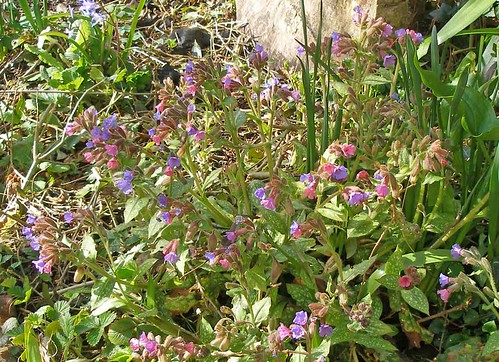
I’ve recently been watching several patches of lungwort (Pulmonaria) in different parts of the town. It’s one of my favourite spring flowers bringing much needed early splashes of colour as well as food for the few bees out and about. I’ve found some of the common form with its pink and blue flowers and dappled green leaves. The Leechwell Garden also has three other cultivars, one with deep blue flowers, another with smaller white flowers and a large patch with coral pink flowers, some tinged with blue.
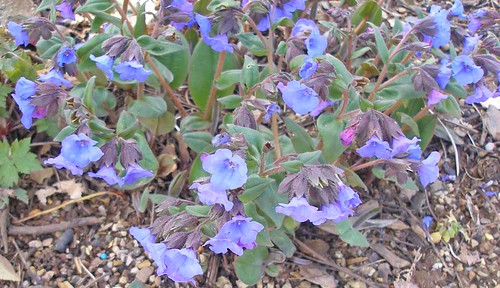


The common form of lungwort (Pulmonaria officinalis) grows wild over much of mainland Europe but it has been naturalised in Britain for many years. The oval, fleshy green leaves are decorated with silver grey spots and grow in a jumble near the ground. In early spring the plant launches volleys of brightly coloured trumpet-shaped flowers carried on sturdy stems. The immature flowers are a deep reddish pink fading to a paler pink as they grow and mature. The flower colour changes again as it ages, this time to a mauvish blue so a vigorous plant may carry two or three principal shades of flower. On a large clump of the plant the flowers shimmer and dance in the cool breezes that predominate at this time of year, creating a haze of strong colour.

There’s an interesting chemical story behind the flower colour change which may transport you back to school chemistry lessons and messing around with litmus paper. The flowers of common lungwort (Pulmonaria officinalis) contain coloured pigments (anthocyanins) that are sensitive to acidity. As the flower ages, there is a change in the pH (a measure of acidity or alkalinity) and the pigments change colour accordingly. The young flowers are acid and their colour is red or pink. As they mature the acidity drops and the flowers eventually turn blue.
But this is more than a chemical curiosity, the colour change is a signal to pollinators. The pink colour tells pollinators that the flower has plenty of nectar whereas the blue says “don’t bother”. Hence pollinators don’t waste time visiting low-nectar blooms and they may visit several plants looking for high nectar flowers increasing the chance of cross pollination. This, of course, raises the question of what happens in cultivars where the flower colour does not change.
It is widely reported that early botanists saw a resemblance between spotty lungwort leaves and diseased, ulcerated lungs. That’s how the name, lungwort and its Latin equivalent, Pulmonaria are supposed to have arisen. I would like to know more about this resemblance because I have no idea what “diseased, ulcerated” lungs look like. I tried to find pictures but that didn’t help either. I wonder which lung disease these early botanists, who were also physicians, were thinking of?
The apparent resemblance between the spotty leaves and diseased lungs also led medieval physicians to use lungwort preparations to treat respiratory conditions. Indeed lungwort has a long tradition of medicinal use and “officinalis” refers to this. In his 17th century herbal, Culpeper asserts: “It is of great use in diseases of the lungs” and to this day, herbalists use extracts of the plant to treat coughs and bronchitis.
The connection between lungwort leaves and diseased lungs did not impress everyone and the plant has a host of other common names of different provenance. Some refer to the Virgin Mary or where she lived, hence the names Our Lady’s Milk Drops, Mary Spilt the Milk and Jerusalem Cowslip. Another name is Soldiers and Sailors which makes a link between the flower colours and the red and blue uniforms of the army and the navy.

But what about those pollinators that are being lured by the siren-colours of lungwort flowers? I’ve seen honey bees and I’ve seen one small bumblebee which I guess is a worker based on its size. But what I’ve been waiting for is Anthophora plumipes or the Hairy-footed Flower Bee and I saw my first one, a male, on March 17. These are fairly large furry bees, the males who emerge first being gingery and the females black. They love lungwort and most days now when I go to see the Leechwell Garden lungwort I am rewarded by the sight of a male with his pale face and characteristic restless, staccato flight pattern. These Anthophora move quickly from flower to flower often buzzing loudly as they go and making it very difficult to take photos. Sometimes they disappear when I arrive but they also sometimes come to have a look; they hover near me, move in a straight line to another spot, hover again and repeat this behaviour around me until satisfied.
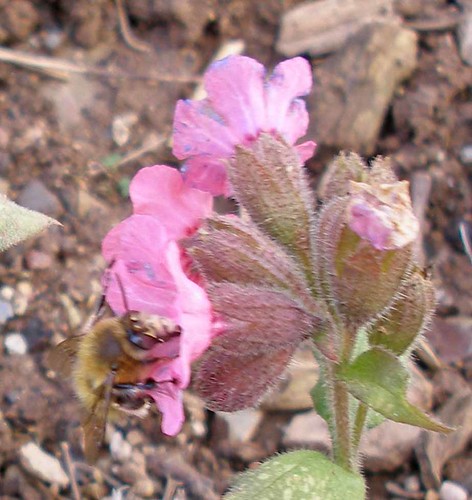
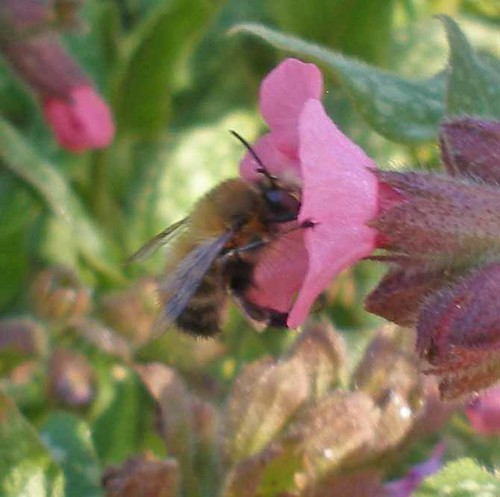
There must be plenty of these solitary bees about for me to see them so easily, unless of course it’s a few very busy bees. So far I have seen no females, but when I do, I will update this.

Update: I finally saw a black female on some primroses on April 12th. Ironically it was in our back garden, although we are quite close the the Leechwell Garden.
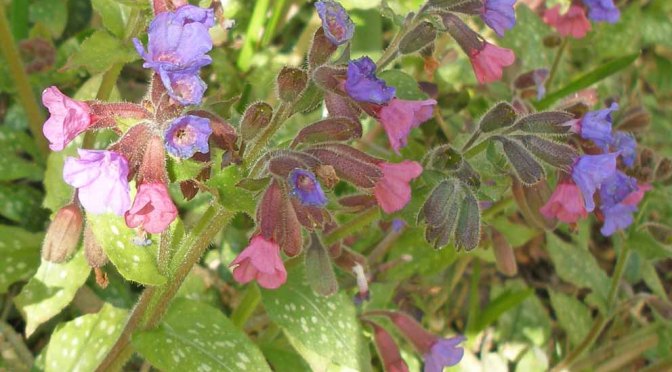

Fascinating, especially the reasons behind the colour change and what it tells pollinators.
LikeLike
Thanks Emily, it is interesting that the flowers are sending signals to pollinators.
LikeLiked by 1 person
Great photos of the male A. plumipes, it is so difficult to get his fringed legs clearly as the hairs are so fine. My males, over here, are grey and it held me back ID ing them as I was comparing with the U.K. My females are not black either and I finally found out that continental ones can be lighter. I look forward to the Pulmonaria in spring too and I never knew about the changes in acidity in the flowers – very interesting. Amelia
LikeLike
Thanks Amelia. I remember the problems you had with identification because of the colour differences. I presume the continental European ones are a different genetic group??
LikeLike
I found our via Steven Falk’s web pages https://www.flickr.com/photos/63075200@N07/sets/72157645501728175/ that there is a different form for the Channel Islands and Europe. I presume it is just a colouring variation as is often found when groups are separated.
LikeLike
Pulmonaria are one of my favourite flowers precisely because of their intelligent colour change and their attraction to bees. Mine have been humming too, and if the sun shines today I will have to try and get some photos!
LikeLike
Thanks Cathy. It would be great to see some photos especially in regard to the colour differences highlighted by Amelia (above).
LikeLiked by 1 person
We have our own little patch of lungwort. Interesting, that little bit of signalling between pollen producer and pollen gatherer…
LikeLike
Yes it’s an interesting story. Do you see these bees on your patch of lungwort?
LikeLike
Can’t say I have, but that doesn’t mean they are not there. The little patch we have is right down the end of our garden where the hive we lost used to be….
LikeLike
More great pictures!
LikeLiked by 1 person
Thanks Lu.
LikeLike
Interesting. I see that I haven’t been paying very close attention to common pulmonaria (Pulmonaria officinalis.) I never knew its flowers changed color as they aged.
LikeLike
It’s well worth a look but here in Devon it has mostly finished flowering for the year.
LikeLike
Did you know that the wort in the name of various plants is another form of the word root? Those two words contain the same etymological root that appears in radical and radish.
LikeLike
Very interesting, I didnt know that. Apparently “wort” was used to denote a plant with a particular medicinal use, many years ago. So we see lungwort, also woundwort etc
LikeLike